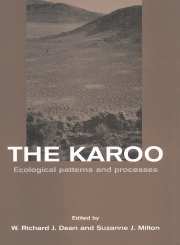Part one - Biogeographic patterns and the driving variables
Published online by Cambridge University Press: 23 December 2009
Summary
More species of plants are packed into the small succulent karoo landscape than in any other desert on earth, yet the vegetation is strangely homogeneous in appearance. This pattern is not repeated in the Nama-karoo, or reflected in the vertebrates of either karoo biomes.
The geological history of the two biomes is similar, being sedimentary, but influenced by folding along the southern and western edges of the karoo, and by igneous intrusions in the northern and eastern parts. The soils of both biomes are typical of arid regions, and are poorly developed with little organic matter. Folding, endorrheic drainage and wind-blown movement of sand has resulted in localized patchiness in substrata which influences the biota.
Anomalous soils developed along the present inland boundary between the winter and summer rainfall regions indicate past shifts in rainfall seasonality (Watkeys, this volume). Pollen core data for the past 10000 years that indicate fluctuations between grass and shrub dominance have occurred repeatedly throughout the karoo (Meadows and Watkeys, this volume). The grass : shrub ratio still follows patterns in present-day rainfall seasonality (Palmer et al., this volume). There can, however, be little doubt that the climate of the western succulent karoo has fluctated less in the recent past and is currently more predictable than that of the Nama-karoo (Desmet and Cowling, this volume).
The biota of the Succulent and Nama-karoo appear to have different geographical origins (Cowling and Hilton-Taylor, this volume; Vernon, this volume). Desert and fynbos genera are prevalent among succulent karoo plants, arachnids, insects and reptiles, whereas Nama-karoo genera have been drawn from savanna, grassland and forest, as well as from the adjacent succulent karoo and desert biomes.
- Type
- Chapter
- Information
- The KarooEcological Patterns and Processes, pp. 1 - 2Publisher: Cambridge University PressPrint publication year: 1999



